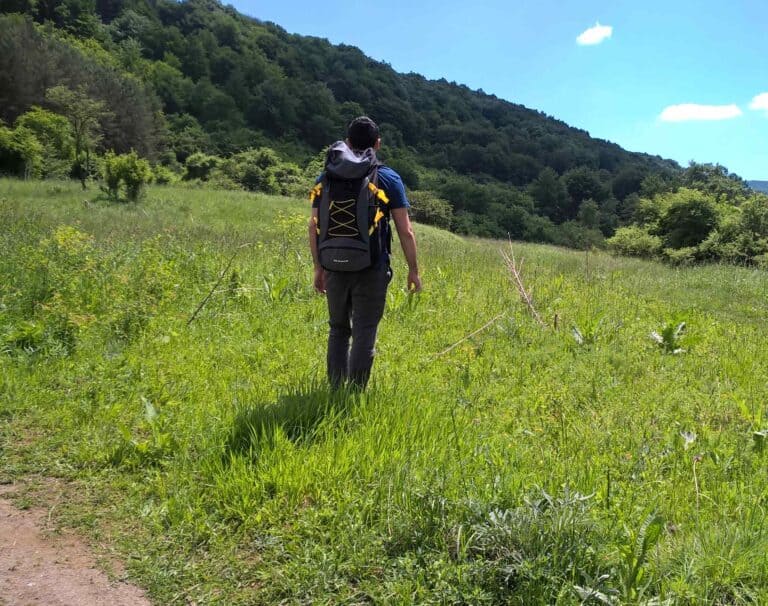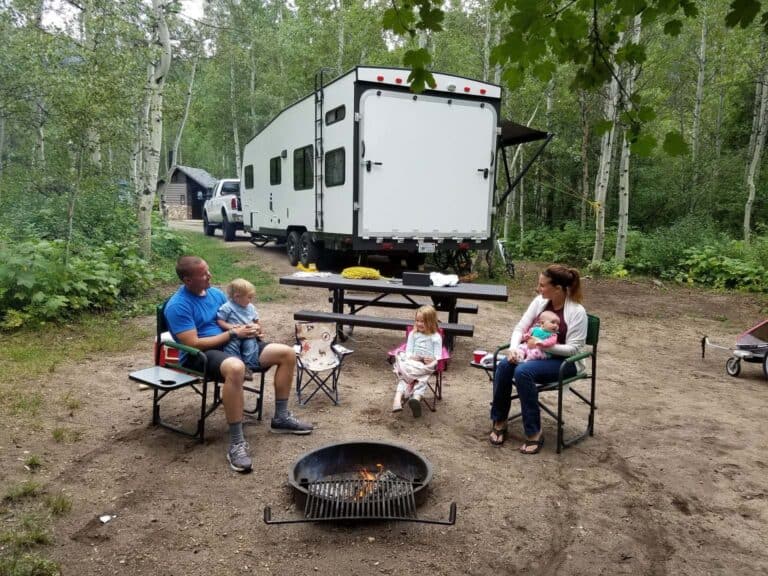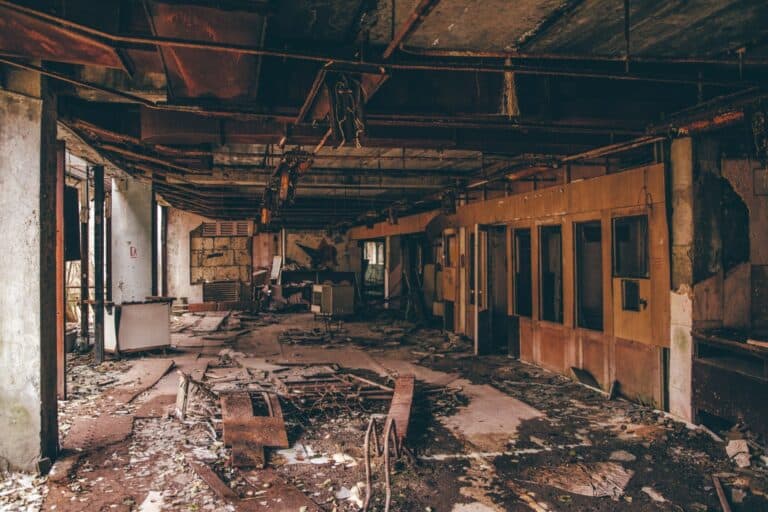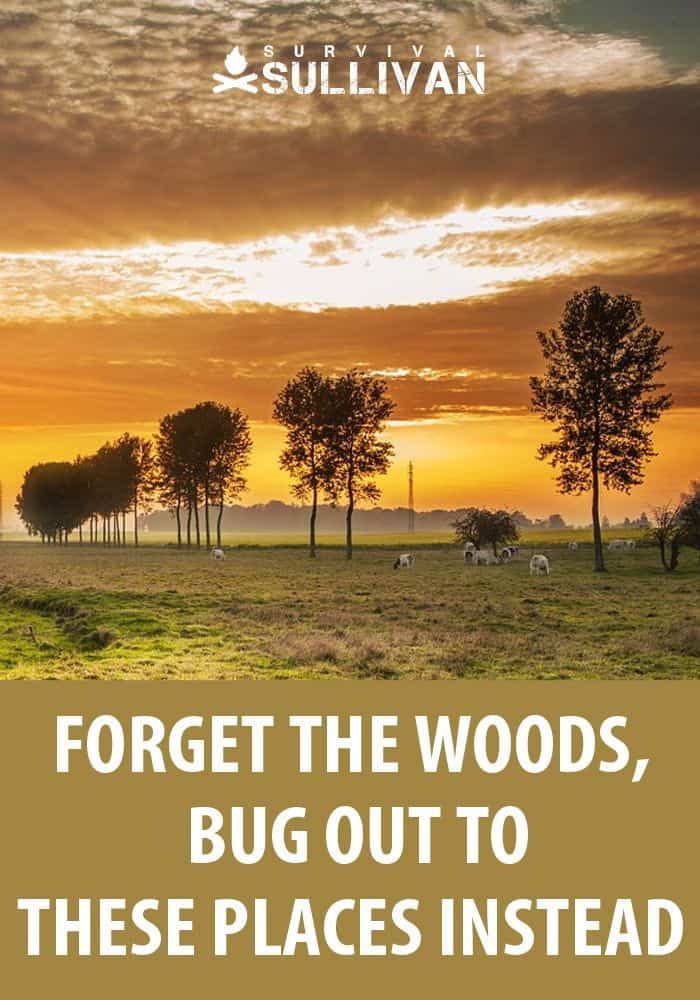There’s a popular strategy among new but also some experienced, yet stubborn, preppers who think that bugging out to a random patch of woods is their best option when SHTF.
If you are in either of these camps, you may be setting yourself up for a harsh reality check when the time comes to bug out.

The lone wolf, “I can survive off the land in the woods”, strategy is not realistic for most people. Sure, perhaps your favorite survival experts, who are extremely experienced and practiced, could survive off the land in the middle of the woods if SHTF.
But even these experts will tell you that surviving in the woods during “normal” times is risky but it’s still much easier than trying the same thing when the entire country is in chaos.
Even if you are a more experienced wilderness person, bugging out to a random piece of land could land you in hot water if you are caught on private property.
During a SHTF event, property owners who may have been lax about monitoring trespassers may be operating on a shoot first ask questions later security strategy.
The last thing you need during a SHTF event is to get shot while trespassing. Plus, for most disasters, you’ll need a semi-permanent shelter in order to survive for several days or weeks, especially in colder climates.
So for those that truly want to survive a SHTF situation for an extended period of time, forget the woods, look in these 9 places that are or should be near you, your home or office, so you can evacuate to either temporarily, or for a longer period of time.
Table of Contents
Private Land You Own or Are Buying
Let’s face it, when it comes to bugging out, most of us realize that buying our own piece of land in a remote location is the ideal bug out location.
If your budget allows for this, it’s definitely the best choice. Look for a piece of property that is a good distance outside of any densely populated city or urban area.
Make sure your property has a fresh water source such as a well, underground spring, or even a lake or pond.
Once you purchase your property, start getting it prepared for a potential bug out by stockpiling food and supplies, setting up a rainwater harvest collection system, solar power, and other things you might need in a grid down or SHTF situation.
The Home of a Relative or Trusted Family Friend
If you can’t bug out to your own privately owned piece of land when SHTF, the next best option might be the privately owned home of a relative or a trusted family friend.
If you haven’t thought about this, take some time to consider your relatives and close friends to identify someone who might be like minded and willing to team up in the event of a disaster.
Perhaps you have an elderly uncle with a large farm who might be willing to trade room and board for your family during a crisis in exchange for your help with security and other survival tasks.
If you’re going to plan on this, it’s absolutely imperative that you discuss your plan with the relative or trusted friend in advance of a crisis. It would not bode well for you to bug out with your family and surprise someone only to be turned away.
Plus, setting this kind of bug out plan up in advance means that you could also ask to stockpile some shelf stable food at that location or perhaps split and chop extra wood for fuel, etc. Anything you can get in place at your intended bug out location in advance, will make your actual bug out easier when the time comes.
Federal Public Land
Many people in the United States may not realize that they have the right to enjoy and utilize any federal public land. This includes areas such as National Forests and Parks, wildlife preserves, and other wilderness areas, including rivers.
Yes, I realize that most of these areas are wooded, but it’s worth mentioning. If you cannot bug out to your own land or land owned by a relative or trusted friend, a nearby area of federal public land might be your next best option.
In most cases you can hunt and if you get deep enough in you could bend trees and use fallen wood to create a shelter or find a cave or rocky overhang.
Again, you will want to scope this out in advance of an actual SHTF scenario. Federal public land is managed by 3 different agencies: (FWS) Fish & Wildlife Services, (BLM) Bureau of Land Management, and the (NPS) National Park Service.
Check the rules and regulations for any areas you are considering. Most National Parks that do charge admission offer annual pass and lifetime pass options which are well worth it if you plan to use the land during a SHTF event. You should include buying a pass as part of your bug out planning.
- Active members of the military and their children are eligible for annual free passes.
- Veterans who are disabled can apply for a lifetime pass at no charge.
- Discounted Senior Passes, formerly called Golden Age Passports, are available for U.S. citizens 62 years of age or older.
- Federal Access Passes are free, lifetime passes, available to U.S. citizens with any percentage of a documented permanent medical disability.
Initially there probably won’t be anyone around enforcing entry requirements immediately after a SHTF event anyhow, but if you are questioned during a SHTF event, you can show your annual pass which entitles you to be there.
In many cases, dispersed camping for up to 14 days is allowed and free of charge. Dispersed camping means you are camping within the National Park or National Forest but are at least one mile from any other area designated as a campground.
State-Owned Land
If you aren’t able to bug out to nearby federally owned land for some reason, your next best bet would be state owned land.
The rules are slightly different for state owned land so make sure you research regulations for your state and do your best to follow any posted signs to minimize any problems. You can find more information on locations of state owned land here.
Campgrounds
For a temporary SHTF event or natural disaster where you just need to get away from your own home and area for a little while, consider nearby campgrounds. You could identify several possibilities in advance, one fairly close and several others that are farther away.

Visit each of these and spend a weekend camping to see how busy they typically are during camping season. Find one that isn’t too busy and approach them about using their site as a backup in an emergency.
Sure, you may have to pay them to stay there but knowing that you have a relatively safe location to bring your camper, RV, or even a tent and stay with your family until your home is safe again will be worth it.
Industrial Buildings (Factories or Warehouses)
One of the locations that many people may not initially consider when they decide to get forget the woods and bug out to another location are industrial buildings such as factories or warehouses.
Again, in a SHTF situation, many of these industrial buildings will be abandoned by owners and employees. Industrial buildings are typically built to withstand quite a bit, and may be sturdier than other buildings.

In addition, they could have working generators and even some supplies that might come in handy.
You may have to face the consequences of trespassing or breaking and entering after the trouble passes but at least you’ll survive the immediate threat.
Bug Out to Ghost Towns?
Another article that advocated like us to forget the woods and bug out to these places instead suggested that perhaps a nearby ghost town might be a possible option.
I’m not sure what the regulations and laws are regarding ghost towns but I do agree that ghost towns. I don’t advocate breaking the law in most circumstances but in a SHTF situation, it’s likely most laws would be unenforced.
Ghost towns, especially those that have been long abandoned and not restored as a tourist attraction, would likely be isolated and would have at least some structures that could still be used for temporary shelter.
If you choose this option, identify the ghost towns of your choice via the link above and visit in advance of a SHTF situation.
Make sure there is fresh water nearby and that any structure you might plan to use for temporary shelter is stable and won’t collapse on top of you. In a widespread SHTF situation, you can use wood from unstable structures to build a new sturdier structure if you think ahead and bring basic tools.
Abandoned Office Buildings
In many cases, when SHTF, people are going to quite quickly abandon their workplaces and head for home to protect their families.
If you find yourself stuck in an urban or suburban location without a pre planned bug out location, look for an abandoned office building as a temporary bug out location.
Many office buildings may even have working generators and other supplies, depending on what type of crisis has hit and how severe it is.
Again, I wouldn’t do this unless rule of law has gone out the window or your situation is very dire because it is considered trespassing and could have legal consequences after the trouble is over.
For added security, identify several office buildings near your home with at least two floors and a basement. This gives you flexibility depending on the type of disaster that hits your area.
For a tornado, you can leave your mobile home trailer and hunker down in the basement of the office building, but for a potential flood situation, you have an option to move to higher ground.
In addition, in an urban area, it’s likely that looters might be dashing in and out of the ground floors of buildings and grabbing whatever they see. In this instance, you can move to the 2nd floor, stop the elevator (if it even still works), blackout windows, and barricade the stairs for additional security.
Areas Along Power Line Easements and Abandoned Logging Roads
The last place I want to briefly mention that you could consider or at least scout out are areas along power line easements or abandoned logging roads.
These areas won’t be very heavily populated, the logging roads or easements are maintained so you can get further into wooded areas and away from prying eyes of people. But again, you could be caught trespassing and could be at risk of being shot by an owner who is monitoring their property line.
So, hopefully I’ve convince you to forget the woods and bug out to alternate places following a natural disaster or SHTF event. Which of these places will you consider for your bug out location? Can you think of others? Let us know in the comments below.


Born and raised in NE Ohio, with early memories that include grandpa teaching her to bait a hook and watching her mom, aunts, and grandmothers garden, sew, and can food, Megan is a true farm girl at heart.
For Megan, the 2003 blackout, the events of 911, and the increasing frequency of natural disasters like Hurricane Katrina, spurred a desire to be more prepared. Soon to be living off-grid, this mother of four and grandmother of ten is learning everything she can about preparedness, survival, and homesteading.

Excellent article! Thank you!
Just my opinion.
You and your MAG should bug out to a local food distribution warehouse or Costco if you end up in a total without rule of law scenario, which is unlikely. Even such a place would be a short-term (6 months to a year) locale before the supplies ran out and you would likely have to defend it against others with the same idea.
Or maybe bug out to the beach, near a river outlet, where you can fish for food and have access to fresh water.
you still need fresh water that’s clean not river water. Costco would mos def not be the place to go. Everyone will be going there too. plan ahead and plan well.
I would have to say a sporting goods store, like Gander Mountain. Gander (went out of business sadly) has steel shutters that close over the windows and doors, plus roof access to dissuade any potential looters. Not to mention ALL of the necessary survival gear it has. THAT is the ultimate BOL!
I’m sure no one else has thought of that.
I believe that the general rules that you wrote are generally correct for National Forests and BLM land. But NOT correct for National Parks. National Parks have far more restrictive rules. In general, no hunting, fishing. collecting edible plants, or cutting live wood (for shelters or other purposes). Rarely, there are local exceptions based on the resources being protected. But what we call “wilderness survival” is forbidden by multiple rules. Similar rules apply to typical State Parks (although the rules vary significantly from state to state). Parks exist to protect the resources, and serve the public only within limits that protect the resources.
National (and State) Forests are “multi-use” areas intended to allow a variety of uses, and thereby serve various public interests. For example, Forests allow controlled cutting of trees, making them a source of lumber, but Parks generally do not. There may be trails where ATVs are permitted. Rules are set to prevent specific localized destruction or over use issues, or to designate different sections for different conflicting purposes. For example, a portion of a Forest might be set aside as a “wilderness area”, in which case that portion might have rules somewhat similar to a Park.
I know several people who could make good use of all those areas if they so choose. The problem is, how to get to the location if it’s a fairly good distance, not easily accessible on foot.
Anothee good choice especially out in the southwest is finding abandoned mines. As long as they are structurally stable they provide alot of things to ease survival. Moderate steady temperatures and often a viable water supply. Do be mindful of critters as some mines or caves are home to alot of things.
I shouldn’t say this but I have a sailboat. I.can go anywhere. Very self sufficient. Very inexpensive. Just saying
Pirates. They have already started attacking boats on the West Coast. During a fall, there are already bad guys ready to hop on a boat and take yours.
1 of the best ideas I have read in a long time.
People, you need to think of places that others are nt going to go to. They will go for food and other items they need and most often they wilol be traveling in groups so when they get to you you are sunk!
Where in Florida can a family escape in a camper equipped as a bug out vehicle that is legal.
Any federal land ? What if Biden forbids it
Other locations to consider, a small town of 5,000 people or less, a houseboat, a bunker, a cabin, an old barn, a ceiling, a truck with camper, any RV and a school bus.